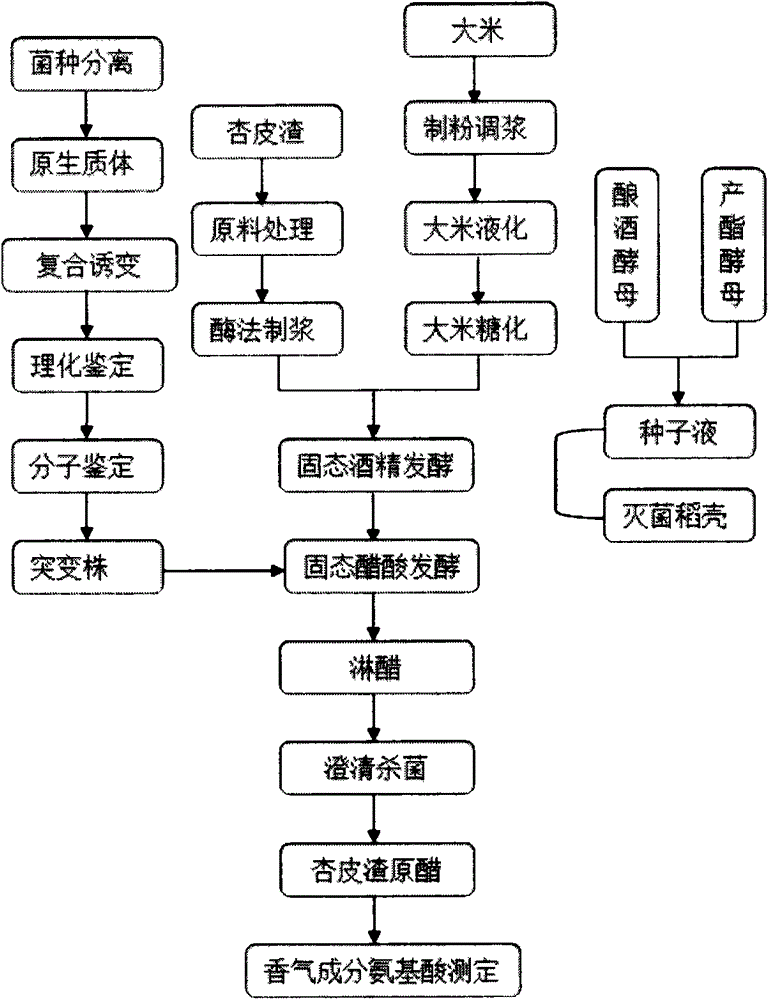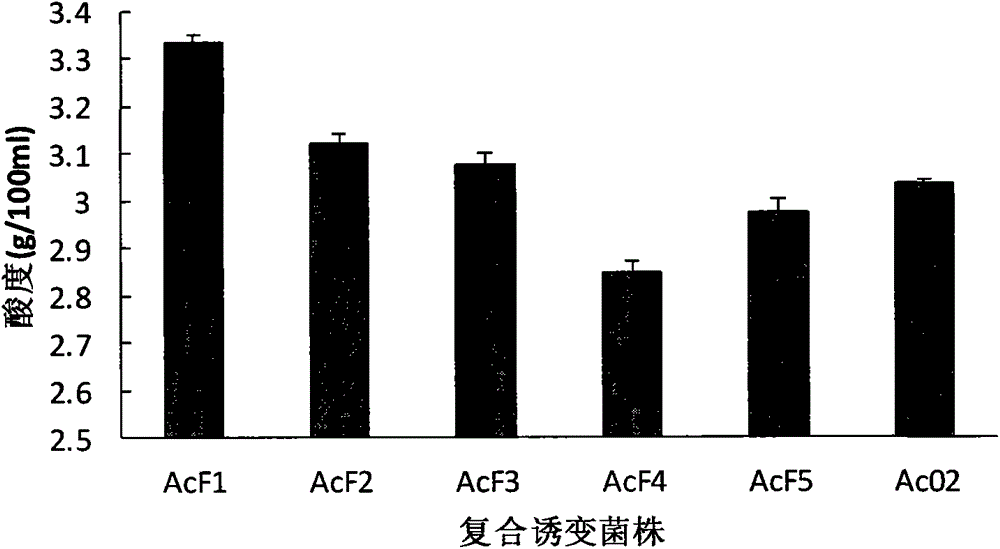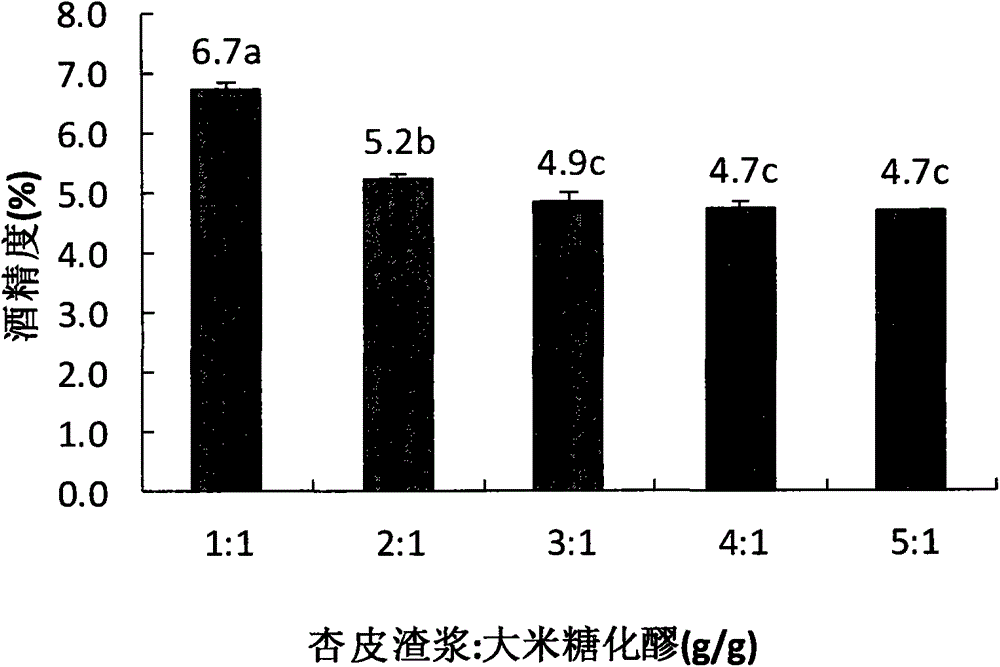Acetobacter and its fruit vinegar prepared by solid-state fermentation of apricot peel residue
A kind of apricot peel residue vinegar, acetic acid bacteria technology, applied in vinegar preparation, mutant preparation, bacteria and other directions, to achieve the effect of adapting to a large temperature range and excellent alcohol resistance
- Summary
- Abstract
- Description
- Claims
- Application Information
AI Technical Summary
Problems solved by technology
Method used
Image
Examples
Embodiment 1
[0045] Embodiment one: preparation and regeneration of acetic acid bacteria protoplast
[0046] (1) Source of acetic acid bacteria: obtained from apricot orchard soil in Luntai County, Bazhou, Xinjiang, China.
[0047] (2) Preparation of acetic acid bacteria protoplasts.
[0048] Inoculate 100ml liquid basal medium with 2% (v / v) inoculum of acetic acid bacteria activation culture medium, culture at 30°C and shake at 120r / min until logarithmic growth phase, take 5ml culture medium, and centrifuge at 3500r / min After 15 minutes, discard the supernatant and leave the bacterial pellet, take 5ml of HM buffer to wash the bacterial cell twice, centrifuge at 3500r / min for 15min, discard the supernatant, suspend the bacterial pellet with 0.2mg / ml lysozyme solution, shake slowly at 30°C , take a smear of the enzymatic solution every 15 minutes, check under the microscope after Gram staining, and check under the microscope that about 80% of the protoplasts are formed, centrifuge at 3500r...
Embodiment 2
[0054] Embodiment two: acetic acid bacteria mutation breeding test
[0055] (1) Determination of optimal time for protoplast ultraviolet mutagenesis
[0056]Dilute the acetic acid bacteria protoplasts prepared in Example 1 with HM buffer solution to 107 / ml, get 4ml and inject it into a sterile plate, and irradiate it with ultraviolet rays with a power of 20W. The treatment time is 15s, 30s, 45s, 60s, 75s, respectively. 90s, the distance of irradiation is 30cm, after appropriate dilution with HM solution after irradiation, carry out protoplast regeneration with double layer method, at the same time, carry out protoplast regeneration with double layer method after diluting the protoplast without irradiation with the same multiple, as comparison. Cultivate at 30°C in the dark for 3-5 days. After the colonies grow, calculate the lethality of the protoplasts and determine the optimal mutagenesis time.
[0057] (2) Determination of optimal conditions for protoplast nitrosoguanidin...
Embodiment 3
[0069] Embodiment three: screening, isolation, purification and identification of strains
[0070] 1. Screening, isolation and purification of strains:
[0071] The present invention takes samples from the apricot producing areas in Xinjiang, screens out a batch of excellent acetic acid bacteria, and uses nitrosoguanidine and ultraviolet rays to alternately treat the protoplasts of the acetic acid bacteria for mutagenesis, and obtains one of the bacterial strains numbered as AcF1, which is identified Acetobacter pomorumAcF1 was used in solid-state fermentation to brew apricot pomace vinegar, and a typical apricot pomorum vinegar was prepared.
[0072] Simultaneously, the invention provides the breeding method of Acetobacter pomorumAcetobacterpomorumAcF1CCTCCNo: M2013554, comprising the following steps:
[0073] (1) Preparation of acetic acid bacteria protoplasts: Inoculate the acetic acid bacteria activated culture solution into 100ml liquid basal medium with an inoculum size...
PUM
| Property | Measurement | Unit |
|---|---|---|
| diameter | aaaaa | aaaaa |
| Bronsted acidity | aaaaa | aaaaa |
| Bronsted acidity | aaaaa | aaaaa |
Abstract
Description
Claims
Application Information
 Login to View More
Login to View More - R&D
- Intellectual Property
- Life Sciences
- Materials
- Tech Scout
- Unparalleled Data Quality
- Higher Quality Content
- 60% Fewer Hallucinations
Browse by: Latest US Patents, China's latest patents, Technical Efficacy Thesaurus, Application Domain, Technology Topic, Popular Technical Reports.
© 2025 PatSnap. All rights reserved.Legal|Privacy policy|Modern Slavery Act Transparency Statement|Sitemap|About US| Contact US: help@patsnap.com



